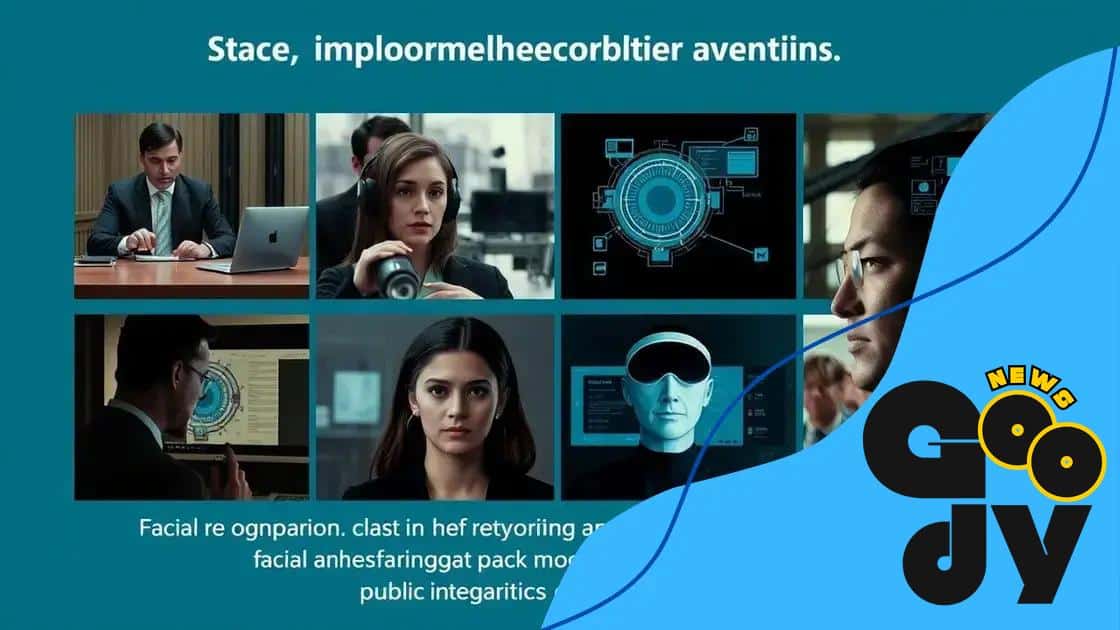The role of facial recognition in enhancing public safety

The role of facial recognition in enhancing public safety includes improving surveillance, reducing crime rates, and aiding in rapid identification during emergencies, all while addressing ethical and privacy concerns.
The role of facial recognition in enhancing public safety is becoming increasingly important. Have you ever wondered how this technology can help keep our communities safer? Let’s dive into its impact and potential.
Understanding facial recognition technology
Understanding facial recognition technology is essential in today’s digital age. This technology allows systems to identify or verify a person’s identity using their facial features. It’s fascinating how this process works and its implications on our daily lives.
How Does Facial Recognition Work?
The technology primarily uses artificial intelligence and machine learning. It analyzes various elements of a face, such as the distance between the eyes and the shape of the jaw. These unique features are then converted into a digital representation.
Key Components
- Image Acquisition: Capturing facial images through cameras.
- Face Detection: Identifying a human face within an image.
- Feature Extraction: Analyzing facial features for recognition.
- Matching: Comparing the detected face against a database.
Once the facial features are extracted, the system creates a unique template. This template is crucial for comparing the real-time image with stored images in databases. When police or security agencies are involved, this technology can significantly aid in identifying suspects and locating missing persons.
Another important aspect to consider is the data privacy surrounding facial recognition technology. Concerns have been raised about how facial data is stored and used. This raises ethical questions about surveillance and consent that society must address.
Efforts are ongoing to improve the accuracy and reliability of these systems. With advancements in technology, the hope is that facial recognition will evolve into a more trustworthy tool, enhancing public safety without compromising individual rights.
Benefits of facial recognition for public safety
The benefits of facial recognition for public safety are significant and multifaceted. This technology plays a crucial role in enhancing security across various public spaces, making our communities safer.
Enhanced Surveillance
One of the main advantages is the ability to improve surveillance. Facial recognition systems can monitor crowded areas and detect suspicious activities in real time. This capability allows law enforcement to respond quickly to potential threats.
Crime Prevention
Another important benefit is its impact on crime prevention. When criminals know that facial recognition technology is in use, they may think twice before committing a crime. This can lead to a reduction in theft, vandalism, and other offenses.
- Rapid Identification: Law enforcement can identify suspects quickly.
- Enhanced Monitoring: Public spaces can be monitored continuously.
- Data Analysis: Behavioral patterns can be analyzed for suspicious activities.
Additionally, facial recognition technology aids in locating missing persons. By comparing images of missing individuals with images captured in public, agencies can reunite families more efficiently. This capability is especially useful during large-scale events where crowds gather.
Moreover, it improves response times in emergencies. During critical incidents, facial recognition can help identify involved parties, expediting medical or law enforcement assistance. The speed and efficiency of response are vital for saving lives.
Despite these benefits, it’s essential to balance the advantages with privacy concerns. Proper regulations and transparency about the use of facial recognition are necessary to maintain public trust and protect individual rights.
Challenges in implementing facial recognition

Challenges in implementing facial recognition technology can significantly affect its effectiveness. Many organizations encounter obstacles when trying to integrate this advanced system into their existing infrastructure.
Data Privacy and Ethics
One major challenge is addressing data privacy and ethics concerns. Citizens often worry about how their facial data is collected, stored, and used. Ensuring transparency in practices is crucial to gaining public trust.
Accuracy and Bias
Another challenge is the accuracy of the technology. Facial recognition systems can sometimes misidentify individuals, leading to false accusations. This problem is often compounded by potential biases in the algorithms, which can perform differently across various demographics.
- False Positives: Misidentifications can have serious consequences.
- Bias in Algorithms: Disparities may arise based on age, gender, or ethnicity.
- Quality of Data: Poor-quality images can reduce accuracy.
In addition to these issues, the implementation of facial recognition technology can require significant financial resources. Organizations must invest in high-quality cameras, software, and training for employees. These costs can be prohibitive, especially for smaller entities.
Furthermore, legal restrictions can complicate the deployment of facial recognition systems. Different regions have various laws regarding surveillance and data usage, making compliance a complex process. Organizations must navigate these regulations carefully to avoid legal repercussions.
Lastly, technical integration poses its own set of challenges. Merging facial recognition systems with existing security protocols can be difficult. This process requires careful planning and technical expertise to ensure a seamless transition.
Case studies of successful implementations
Case studies of successful implementations of facial recognition technology show how it can enhance public safety in real-world scenarios. Many cities and organizations have adopted this technology with impressive results.
Example 1: Public Transportation Security
In cities like London, facial recognition is used extensively in public transportation systems. Transport authorities have integrated this technology to monitor train stations and bus depots. The results show a marked decline in crime rates within these areas.
Example 2: Event Security
Another notable implementation is at large-scale public events. For instance, the Super Bowl in the United States utilized facial recognition technology to enhance security measures. The system was able to identify individuals on watch lists and quickly alert security personnel.
- Rapid Response: Increased ability to respond to potential threats.
- Improved Crowd Management: Helped manage large crowds efficiently.
- Enhanced Safety: Reduced incidents of violence and disturbances.
These case studies highlight the benefits of using facial recognition to improve safety and security. They also illustrate how technology can adapt to various environments, from urban transportation to major public events.
Additionally, companies like Amazon have implemented facial recognition in their retail stores. This tech not only monitors suspicious behavior but also aids in inventory management by tracking customer interactions with products. This data is valuable for understanding consumer behavior and improving service.
Overall, these successful implementations demonstrate that while challenges exist, the advantages of facial recognition can lead to safer communities and more effective public safety strategies.
Future trends in facial recognition for safety
The future trends in facial recognition for safety look bright, as technology continues to evolve rapidly. Innovations in this field promise to enhance security while addressing ethical concerns.
Integration with Artificial Intelligence
One major trend is the integration of artificial intelligence (AI) with facial recognition systems. This combination can lead to more accurate identification and faster processing times. AI algorithms will help reduce errors, making systems even more reliable.
Focus on Privacy and Ethics
As public concern about data privacy grows, there will be a stronger emphasis on ethical practices in facial recognition. Future solutions will likely include transparent data collection methods and strict regulations to protect individuals’ rights.
- Privacy-First Solutions: Emerging technologies that prioritize individual privacy.
- Consent-Based Systems: Users will have more control over their data.
- Secure Data Storage: Improved methods for safely storing biometric data.
The development of real-time analytics will also play a crucial role in future implementations. This technology will allow security personnel to make quick decisions during emergencies, thanks to instant data processing and analysis.
Moreover, advancements in biometric technology will enhance accuracy. Future systems might include even more sophisticated features beyond just facial recognition, such as analyzing voice or gait patterns.
Collaboration between various sectors, including technology companies and law enforcement, will drive innovation. By working together, these groups can create robust systems that not only enhance safety but also respect community values.
Overall, as we look to the future, the trends in facial recognition indicate a shift towards safer, more responsible use of technology in public spaces.
In conclusion, facial recognition technology is transforming how we ensure public safety. As we’ve discussed, it offers various advantages, such as improving security in public spaces and aiding in crime prevention. However, it also faces challenges, including ethics and privacy concerns. Looking ahead, the integration of artificial intelligence and enhanced ethical standards will shape the future of this technology. By balancing innovation with respect for individual rights, we can harness the power of facial recognition for a safer and more secure society.
FAQ – Frequently Asked Questions about Facial Recognition Technology
What are the main benefits of facial recognition for public safety?
Facial recognition enhances public safety by improving surveillance, preventing crime, and aiding in locating missing persons.
What challenges does facial recognition technology face?
Challenges include data privacy concerns, accuracy and bias in algorithms, and the need for significant financial investment.
How does artificial intelligence improve facial recognition?
AI enhances facial recognition by increasing accuracy, reducing false positives, and enabling real-time analysis.
What are the future trends in facial recognition technology?
Future trends include ethical practices, better integration with AI, and enhanced community engagement to build trust.





